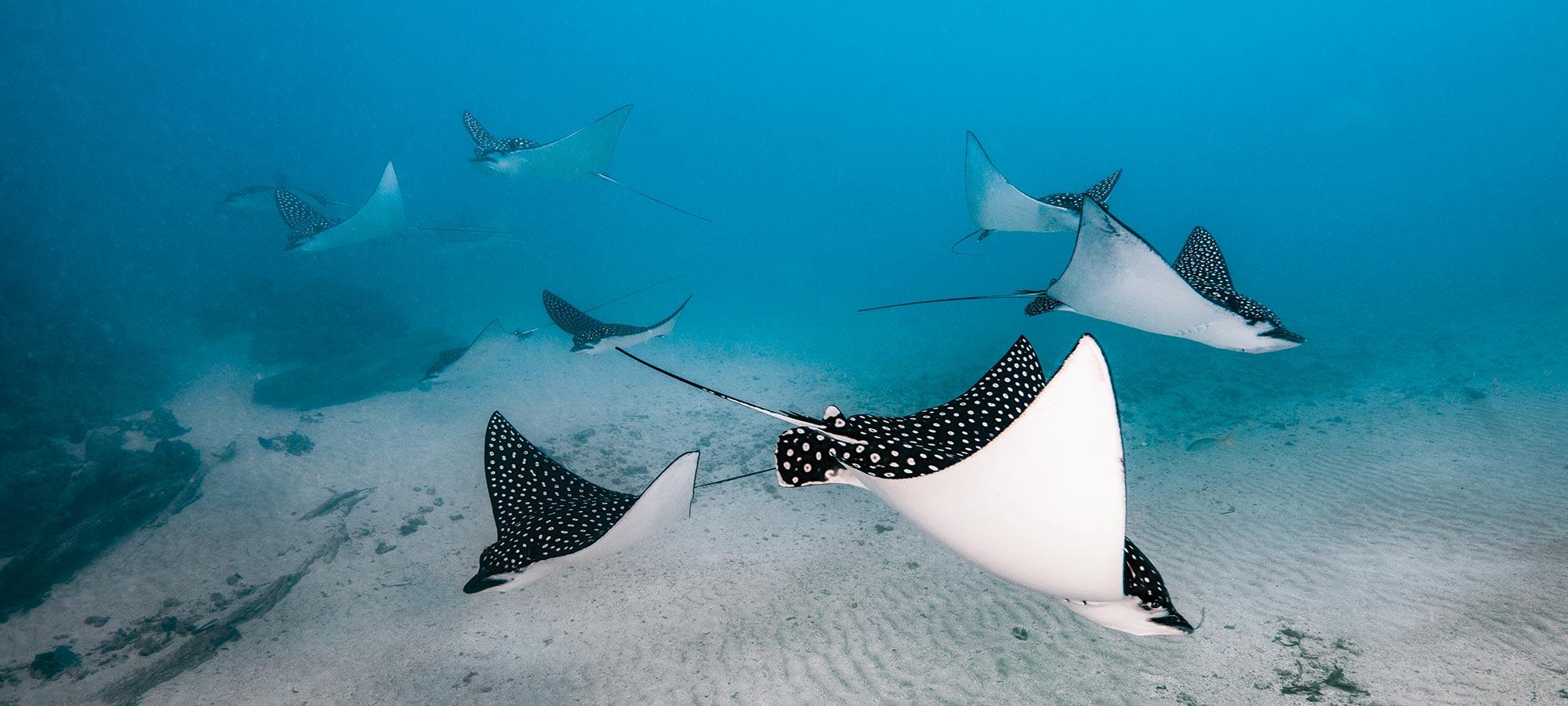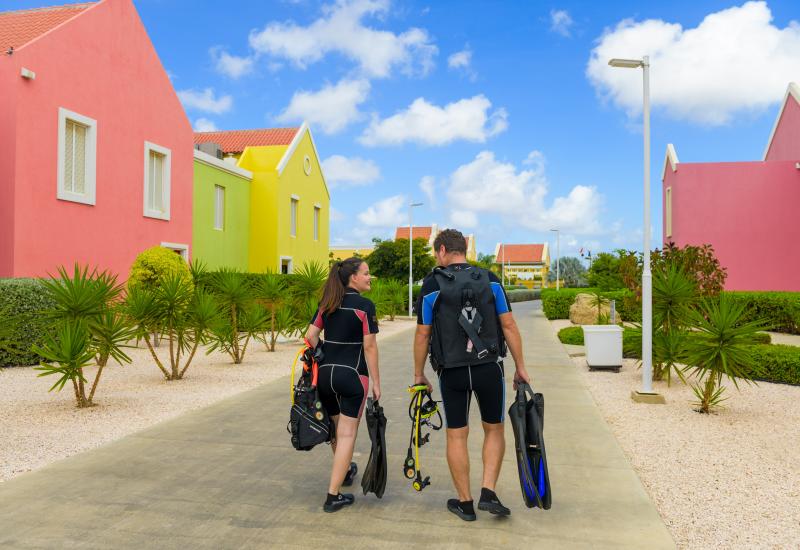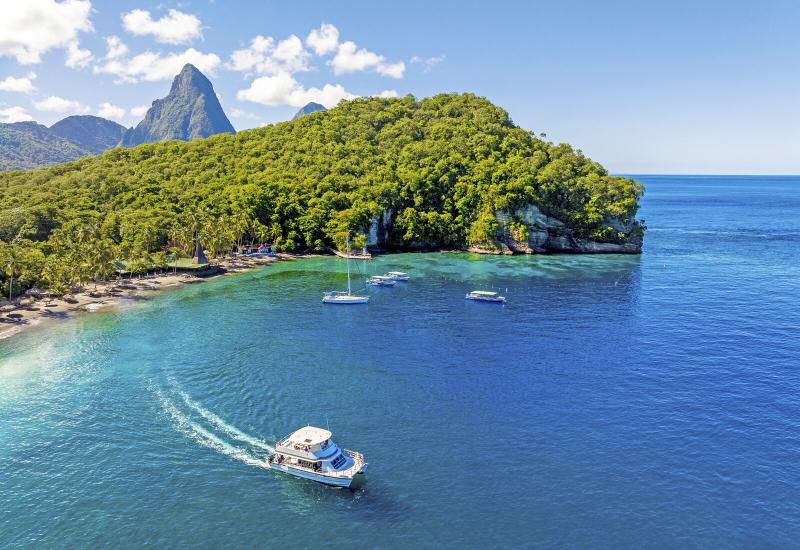The Best Under-the-Radar Caribbean Islands for Scuba Diving
Divers love the islands of the Caribbean. And the Atlantic. (We see you, Bahamas.)
But the secret is more than out about much of the best diving in most of the region. Where, we wondered, can you still find the Caribbean as it was 10 years, 20 years, 30 years ago? We asked the divers who get around the most — photographers — and here’s what they had to say.
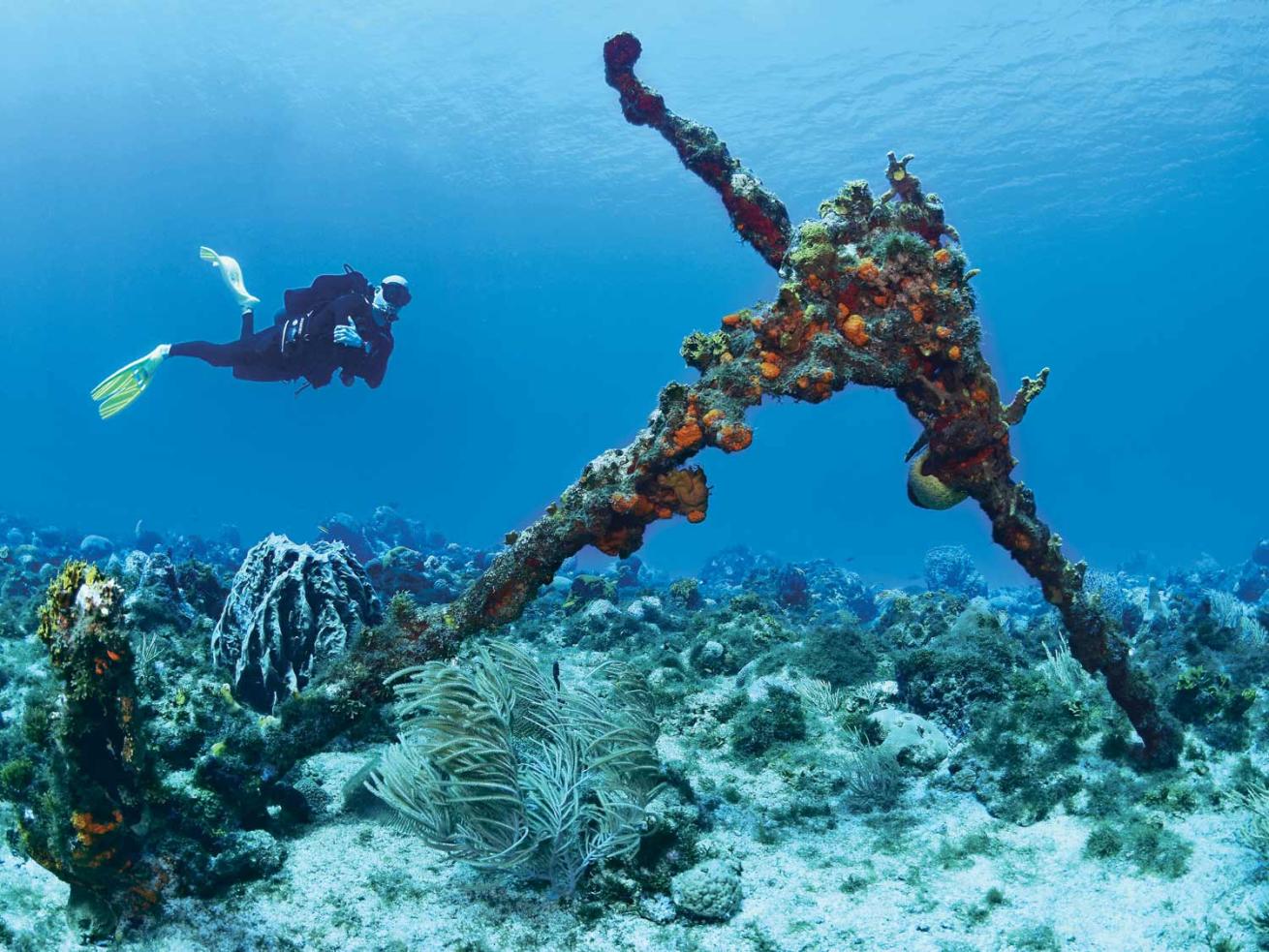
Jan ZegarraHome to some of Puerto Rico's best diving. Desecheo is a uninhabited island that is managed as a wildlife reserve by the U.S. Fish and Wildlife Service.
Puerto Rico
Take a Walk on the West Side
Puerto Rico’s east side is known to divers for special places such as Vieques and Culebra islands, but as the saying goes, when it comes to scuba, “west is best.” From the northwest to southwest, this coast harbored pirates, and is where U.S. troops landed during the Spanish-American War of 1898.
The region is known mostly for stunning beaches and surf, but its less-well-known gems — diverse scuba spots — are just as exceptional.
One of the best-loved spots in Puerto Rico is Crash Boat Beach in the northwest, an easy shore dive with lots of fish among the remains of a pier that serves as an artificial reef, great for any certification level and a mecca for macro photographers. For more-advanced divers, check out the historic B-29 bomber at around 115 feet, also offering great photo opportunities. A must-do is the Desecheo Island marine reserve, with options for experienced divers such as the action-packed Yellow Reef to the more mellow and colorful reefs at Candyland. Nurse sharks abound in Mayagüez and Cabo Rojo, offering some of the most underrated scuba diving in Puerto Rico. And don’t forget to explore the magnificent wall and reef dives in Guánica or Parguera, where you are likely to swim among sea turtles, big green moray eels and the occasional reef shark. Whatever your scuba preference or skill, Puerto Rico’s west side can accommodate.
—Jan Zegarra
Need To Know
Language: Spanish, but English is widely spoken.
Topside draw: Great food and coffee, music, beautiful landscapes, and lots of smiling locals. Go back in time in historic Old San Juan for a change of scenery.
Getting There: Luis Muñoz Marín International Airport (SJU) in San Juan or Rafael Hernández Airport (BQN) in Aguadilla.
Fun Fact: Legend has it that there are hidden treasures on the southwest side from the famous pirate Roberto Cofresí.
Average Water Temp: High 70s to mid-80s
Average Viz: 30 to 100-plus feet When to Go: You can dive year-round, but be mindful of the rainy season June to November. During the drier season, December to May, the viz tends to be better.
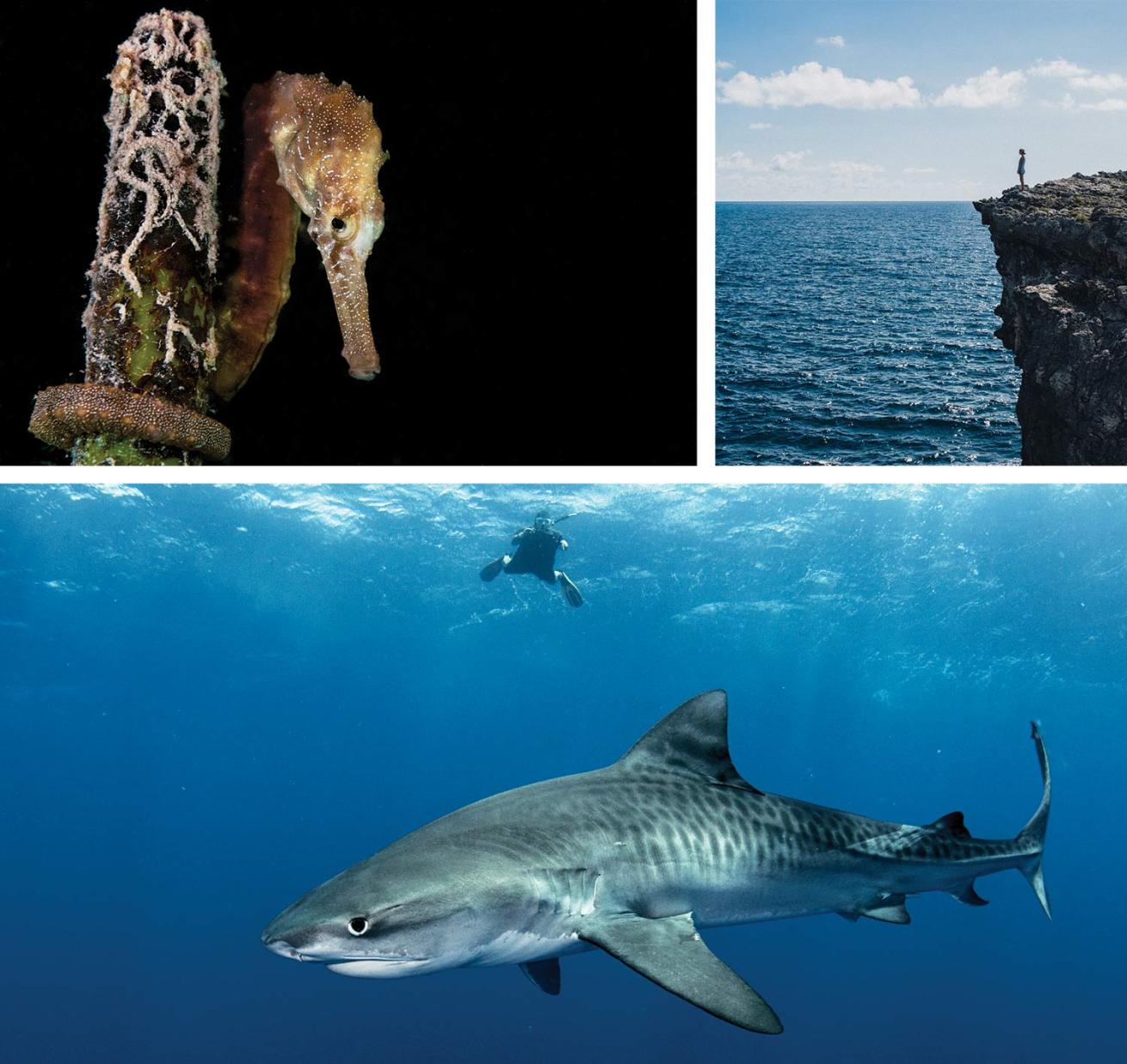
Shane GrossA lined seahorse clings to a mangrove shoot; sheer cliffs on Eleuthera's east side plunge into the sea; a passing tiger shark wows a snorkeler at the surface.
Eleuthera
Wild and Free in the Bahamas
Every island has something special and unique about it. Eleuthera, an out island in the Bahamas, and its two satellite islands, Spanish Wells and Harbour Island, are certainly no exception. You can feel it as you explore the island above the water, and you feel it once you’re submerged. There’s a wildness you don’t find just anywhere these days. There are no purpose-sunk shipwrecks, only natural ones. There are no underwater art installations, only reefs built over the centuries. There are no regular shark or stingray feeds, but both animals are often seen. One thing you won’t see is another dive boat.
While great deep dives such as the Arch or Plateau are available, you really don’t need to go deep. In fact, the most exciting sites are often the shallowest. At Pink House Reef (25 feet), you are likely to come across massive eagle rays in winter and huge tarpon in summer. At Sea Garden (35 feet), you are guaranteed to see a quantity and variety of fish rarely found in the Caribbean anymore. At Blowhole (55 feet), you will dive a towering cliff with swim-throughs and boulders that would make you think you were diving off California if it weren’t for the green turtles and midnight parrotfish. If you’re looking for a real adventure, try drifting through Current Cut at 6 knots looking for sharks, turtles and schools of eagle rays. For the macro lover, you’ll see plenty of blennies, grass squid and maybe even a seahorse. (And don’t turn up your nose at mangrove snorkeling!)
—Shane Gross
Need To Know
Language: English
Topside Draw: Harbour Island has a pink-sand beach that is never hot to the touch, and plenty of top-rated restaurants.
Getting There: You can connect internationally through Nassau or fly directly to Eleuthera via Miami, Fort Lauderdale and Atlanta.
Fun Fact: The first European settlers of the Bahamas fled religious persecution in Bermuda and landed on Eleuthera in 1648, taking shelter in Preacher's Cave, a historic site that should be on your must-visit list.
Average Water Temp: 85°F in summer; 75°F in winter
Average Viz: 80 feet
When to Go: You can dive year-round; however, winter brings stronger winds and cooler waters. During September and October, many hotels, restaurants and dive shops are closed.
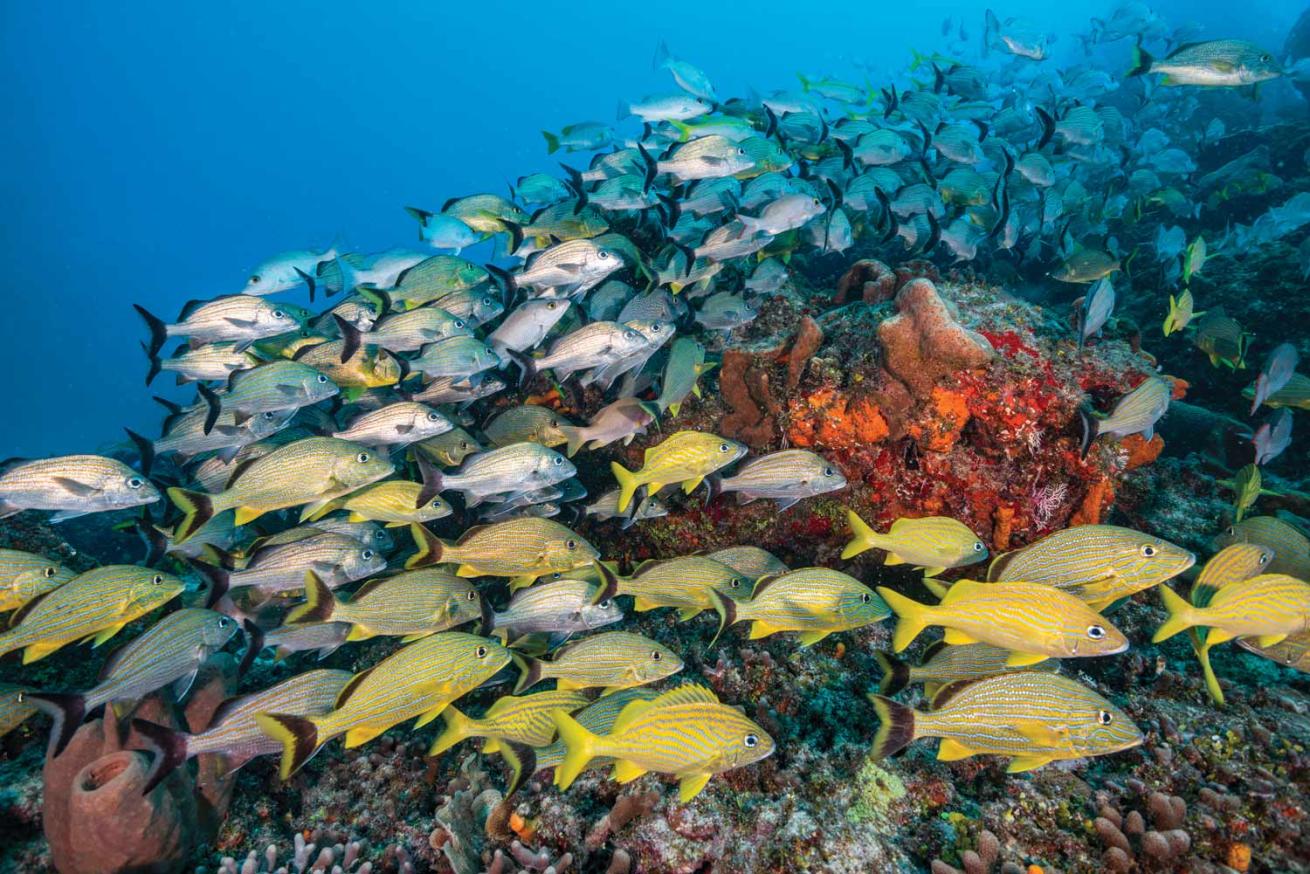
Martin StrmiskaGrunts school at the Little Corn site Blowing Rock.
Little Corn Island
Pluck a Mango and Stay Awhile
Every destination has its “golden time,” that peak period when it emits a vibe that mixes an original taste layered with a cool tourist flavor. While many Caribbean destinations were in their golden years 20 years ago — or more — Nicaragua’s Little Corn Island has that vibe just about now. On an island with very little development, it’s mostly young backpackers diving and snorkeling during the day and sipping beers right on the beach at night. Walking from basic bungalows to dive centers, they refresh themselves with mangoes taken from trees on the forest path.
In a way it reminds one of Utila, in Honduras, but the diving has a different character. On the west side, Little Corn is lined with coral garden spots, while the rougher east side has big shallow lagoons fringed with barrier reefs, and a number of intersections used by bigger animals to get in and out of the lagoon.
My most memorable experience underwater happened in such a channel. The sea was quite rough that day, causing limited visibility and greenish water at the surface. Down at 65 feet, where the view opened up, a great hammerhead immediately came in to check me out, returning several times to the lagoon entrance until I finally realized why: a massive school of eagle rays, no fewer than 50 individuals, passing in and out. I hid myself behind big rocks and tried to become invisible to capture photographs of these majestic yet shy animals.
—Martin Strmiska
Need To Know
Language: Spanish; however, mostly Creole is heard on Little Corn. English is widely understood.
Topside Draw: Walking through the jungle and meeting happy kids playing with their self-made toys and climbing the highest palm trees document the easygoing life here. The laid-back, slow-motion mood transmits so easily that soon one finds oneself swinging in a hammock and listening to the murmurs of the sea rather than going diving.
Getting There: International flights bring travelers to Managua; from there domestic airline La Costeña flies to Big Corn three times a day. The real adventure, however, is the panga ride to Little Corn — during windy season, December to May, the ride can be quite bumpy, and wet.
Average Water Temp: 80°F to 85°F; a 3 mm shorty or fullsuit is perfect.
Average Viz: 80-plus feet
When to Go: Weather is stable throughout the year, with June to August being the rainiest period.
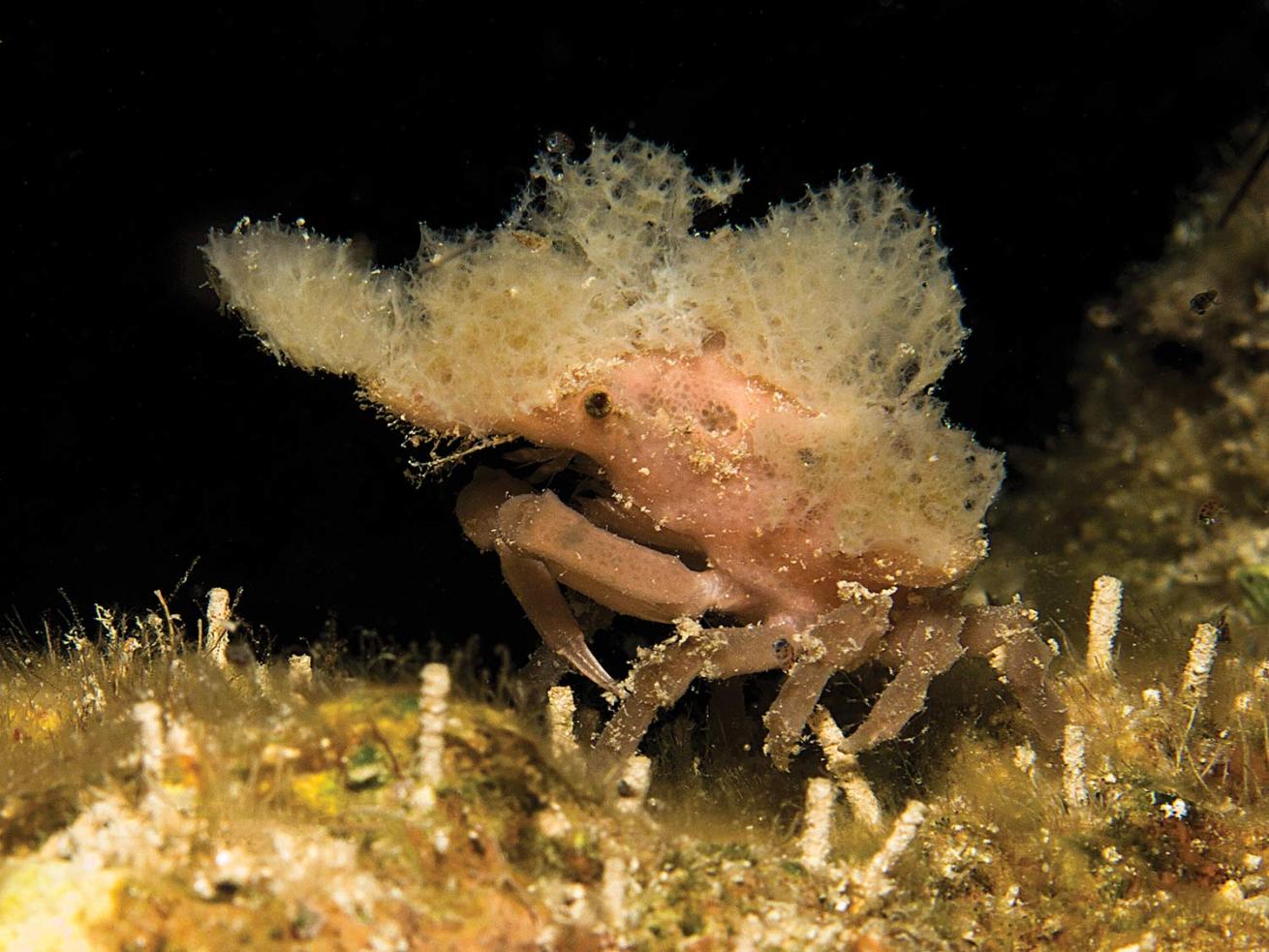
Mickey CharterisA decorator crab spotted off Guanaja.
Guanaja
The Good Life in the Slow Lane
Guanaja is the least visited of the Bay Islands, but it offers up some of the best diving in the western Caribbean, much of it unexplored. Utila has its backpacker charm; Roatan is developing fast with cruise-ship ports and golf courses; but the last island in this chain north of Honduras offers the feeling of stepping back in time to an older, slower, more idyllic Caribbean way of life.
I’d lived in the Bay Islands for almost 20 years when Villa on Dunbar Rock invited me out to Guanaja to stay and dive and photograph their reefs. I wish I had gone long before. The diving is, in a word, incredible. Don’t expect many big-animal sightings here, although eagle rays and dolphins are common. The real beauty is the health and diversity of the reef itself. The macro possibilities are endless, with little rarities such as nudibranchs and top snails I had seen only in books popping out everywhere. Other dive sites such as Black Rock Canyon are cathedrallike in scope — imagine a series of swim-throughs, and then stretch them up to 100 feet tall and fill them with bright gorgonians. The Pinnacle comes up from the depths to explode into a mass of black corals and rare telesto corals; Jim’s Silverlode is packed with silversides, and there’s also the wreck of the Jado Trader to explore. Since the island is bisected by a navigable channel linking its two sides, any day of the year you can dive on a sheltered leeward dive site, each one offering its own charms and surprises.
—Mickey Charteris
Need To Know
Language: English, Spanish
Topside draw: Wander through Bonacca Town; this cay has around 6,000 residents but no cars or roads, just quaint waterways and alleys between houses up on stilts. Grab a beer or a loaf of coconut bread and meander through town; you’ll see why it’s known as the “Venice of the Caribbean.”
Getting There: Flights are available from Roatan through La Ceiba via Lanhsa Airlines Monday through Saturday.
Fun Fact: Christopher Columbus made landfall here on his fourth and final voyage on July 30, 1502, and named it Pine Island for its forested mountain slopes. Visiting its waterfalls, he declared he had “never tasted water of better quality.” Islanders are proud to take visitors to the falls.
Average Water Temp: 76°F in winter; up to 86°F in summer
Average Viz: 80 to 100 feet
When to Go: February through September to avoid rainy season
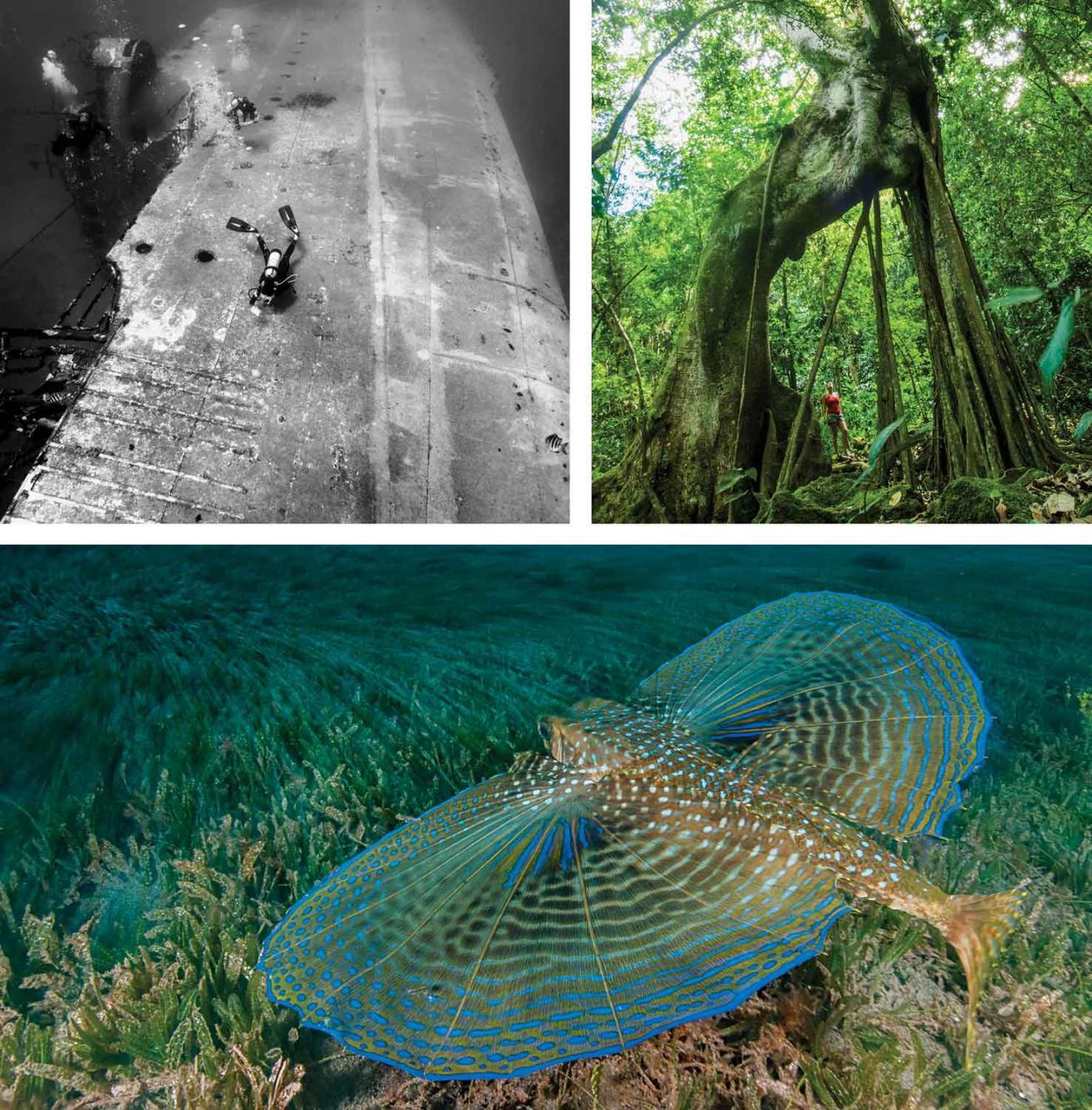
Mike HarterinkThe Charles Brown spans over 300 feet in length the Quill volcano offers a scenic hike; a flying gurnard spreads its wings and flees when threatened.
St. Eustatius
Where Treasure Finds You
Twenty minutes ago I left St. Maarten, and now I’m stepping out of a Twin Otter airplane, the only way to get to St. Eustatius, or Statia, at the F.D. Roosevelt Airport. No conveyor belts here, just a hole in the wall and a friendly guy on the other side who hands over my luggage with a smile. The only traffic I encounter during the five-minute ride to Lower Town is caused by goats.
Ironically, this was one of the busiest Caribbean ports in the 17th and 18th centuries. Unaffected by cruise ships and shopping malls, with not a single traffic light, this is not your average tourist island. Imagine the Caribbean decades ago, and you’ll get close — with friendly locals and family-owned hotels, restaurants and bars.
The reefs surrounding St. Eustatius are flourishing in a protected marine park. Underwater you experience what much of the Caribbean must have looked like many years ago. Sharks and turtles are a common sight; after 10 minutes we stop even trying to count the lobsters. Even more exceptional are the tiny pike blennies and bright-blue flying gurnards. Most of Statia’s 36 official dive sites are located in the marine park, which covers twice the area of the island. The Quill, an eye-catching volcano, dominates the island with its impressive crater, and is responsible for the huge amount of lava flows and blocks under the surface, ancient lava labyrinths now overgrown with coral and sponges. Add to the mix impressive wrecks such as the 327-foot-long Charles Brown and some of the best-preserved historical dive sites I’ve ever seen, and you’ll understand why I’ve co-owned Scubaqua Dive Center for 10 years now.
—Mike Harterink
Need To Know
Language: Officially Dutch, but everyone speaks English.
Topside Draw: Put on your hiking boots and climb the dormant volcano. The view from the rim is like something out of Jurassic Park.
Getting There: From St. Maarten, Winair flies frequent 20-minute jaunts to St. Eustatius.
Fun Fact: Wherever the Dutch went during the 17th century, they traded beads. One particular type, pentagonal blue glass beads, are found only on Statia. Manufactured in Amsterdam and used as currency among slaves on the island, legend has it that after emancipation, the former slaves walked to the shore and threw their blue beads into the sea to celebrate freedom. If a bead “finds” you, you belong to Statia and will return.
Average Water Temp: 80°F
Average Viz: 80 feet
When to Go: Year-round except September, which is hurricane season
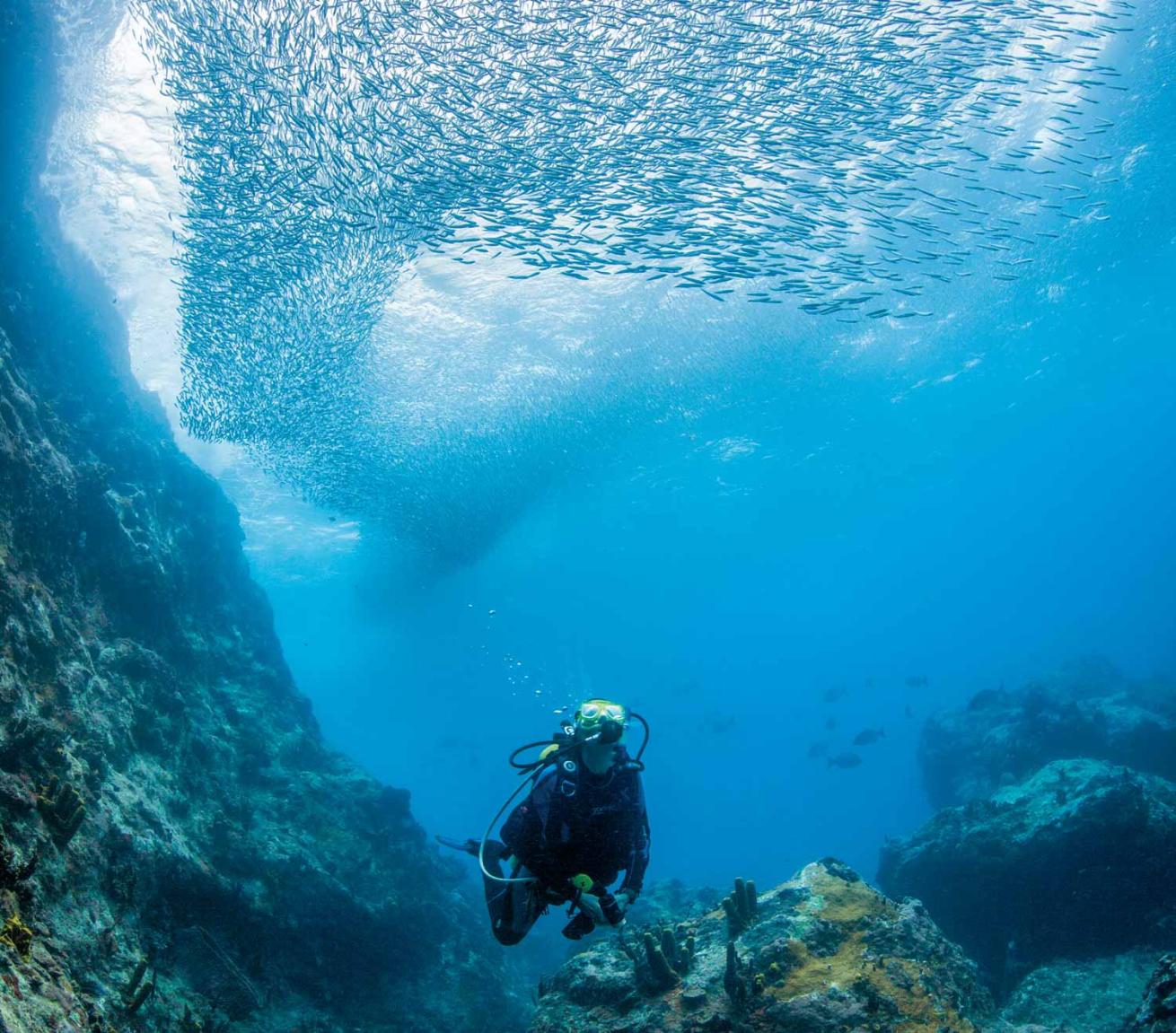
Jill HeinerthA bait-ball completes the view for a diver exploring the waters of Carriacou, part of a three-island state that includes Grenada and Petite Martinique.
Carriacou
Open Doors and Open Hearts
Part of a three-island state that includes Grenada and Petite Martinique, Carriacou feels more connected to South America than the Caribbean. One hundred miles north of Venezuela, at the southern end of the Eastern Windward Islands, Carriacou’s barefoot, leave-the-door-open comfort offers a vibe that has been lost in many other Caribbean ports. Endowed with a panoramic view of the lush tropical landscape, the stately Grandview Hotel overlooks verdant hillsides that undulate down to the sea. Here gauzy curtains waft into the large room, filling it with the aroma of fragrant blossoms.
Motoring through the oyster beds of Tyrell Bay, I spot two volcanic rocks protruding on the horizon. Darwin missed documenting this freakish habitat, where eccentric tendrils of greenery drape jagged, windswept crags. The lower half of the rocky pinnacles are painted white by the swarm of birds that have claimed this offshore rookery. Beneath the ebb and flow of crashing waves at Sisters Rocks is an abundant nursery that endows the northbound currents with swarms of silvery baitfish.
A brisk flow whisks us past giant soft corals, sea whips and abundant gorgonians. Purple creole wrasse rain down, pulsing in a swirling vortex of life, while a small shark zips through the cloud to find refuge in an overhanging cave.
There are moments in the underwater world when you’re wrapped into the tableau of life to become a part of the ocean. Carriacou is that place — one that time forgot — friendly, untamed and yet relaxed, with a healthy environment that feels like an island lost in time.
—Jill Heinerth
Need To Know
Language: English, but learn a bit of the local Creole patois.
Topside Draw: Enjoy lionfish pizza and Grenadian dark-chocolate ganache at casual cafes and elegant bistros such as open-air Slipway restaurant or local artisan’s Gallery Cafe.
Getting There: Major airlines service Grenada and Barbados. From there, quick daily flights reach Carriacou, but it’s more fun to take the ferry from St. George’s, Grenada.
Fun Fact: The local Caribs named the island Kayryouacou, or “land surrounded by reefs.”
Average Water Temp: 79°F to 84°F
Average Viz: 30 to 100 feet
When To Go: Rarely ravaged by hurricanes; visit any time of year.

